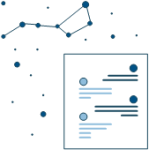
Cognitive Telescope Network
Follow up of transient astronomical phenomenon with a global network of telescopes.
Overview
Telescopic follow-up of transient astronomical events is one of the most desirable and scientifically useful activities in modern observational astronomy. From a scientific perspective, pinpointing a transient event can be essential for discovering more about the source, either by directing more powerful telescopes to observe, or to maintain a near continuous record of observations as the transient evolves. Very often transients are poorly localized on the sky and telescopes have a limited field of view thus pin-pointing the transient source is often a daunting task. Perhaps most importantly, the number of large telescopes on the planet is small, and they cannot be commandeered to randomly search for every transient of interest.
Modern sub-meter class telescopes, of the sort often owned by universities and increasingly by amateurs, if properly directed, could play an important role in enabling transient follow-up. Modern technology gives them the ability to be automated and controlled remotely and to make useful imaging observations that will enable follow-up work by other, larger telescopes. The Cognitive Telescope Network (CTN) will be a framework that takes notifications of transient events and intelligently instructs a network of sub-meter telescopes mapped into a grid and observe a large region of the sky that likely contains the transient event, based on the geolocation, weather and properties of the individual telescopes. The goal of CTN is to collect the data from this network of small telescopes, evaluate and classify that data to identify the most likely candidates for the transient being hunted and deliver the results to the astronomer community for further analysis by larger telescopes for directed and focused observations.
Architecture
The diagram illustrates the intercommunication between the components. For details please refer to the components.

Personas
Designing a solution requires empathy for the users. Here are some of the personas who may benefit from the product.

Research
Community
Observations for specific research experiments may be scheduled reliably through the network and analyzed using Deep Learning models.

Amateur
Community
Observations may be triggered from events being monitored by selecting contributing telescopes that satisfy the criteria.

Enthusiast
Community
Science enthusiasts can look for astronomical information and data and retrieve images from telescopes in the network.
Components
This section shows all the major components of the project. The components are grouped under Hills or Epics for Cognitive, Internet-of-Things, etc. and Foundation.

Observing
Director
Placement algorithm for telescopes based on optimized Tiling and Directed Search criteria.

Telescope
Commander
Observations may be triggered from events being monitored by selecting contributing telescopes that satisfy the criteria.

Astronomy
Assistant
Science enthusiasts can look for astronomical information and data and retrieve images from telescopes in the network.
Projects
Collaboration with universities IBM Center for Advanced Studies and IBM Academy of Technology. Each Open Project is an iteration of a component of the asset.

Illinois Institute of Technology

Dr. Jeff Terry,
Professor of Physics,
Professor of Materials Science and Engineering,
Interim Chair, Department of Social Sciences
Project Id:
ctn-iot-tcom-015-iit
Program:
Component:
Telescope Commander
Groups:
Java, Server, Observatory, Imaging, Swift, Protection
Students:
27

IBM Academy of Technology

Rahul Gupta, STSM
Executive Architect,
Tiger Team,
IBM Consulting
Project Id:
ctn-phase-ii
Program:
Component:
Telescope Commander
Groups:
UX, Testing, API, INDI client
Developers:
10
Presentations
Student and professional presentations on the latest completed iterations of developments for the asset.
“In the vastness of space and the immensity of time, it is my joy to share a planet and an epoch with Annie.”
Carl Sagan, Cosmos



